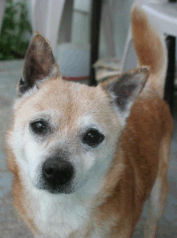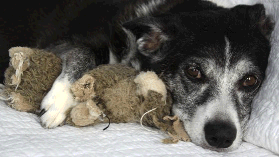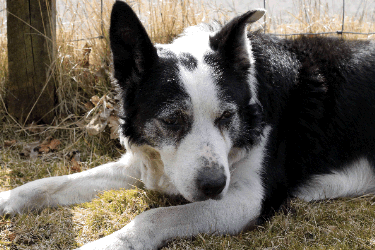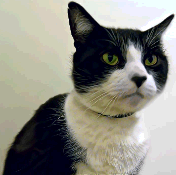|
CANINE AND FELINE COGNITIVE DYSFUNCTION

 (Photocredit: Morguefile.com) (Photocredit: Morguefile.com) |
The sad fact is that pets do not live nearly as long as people and the playful puppy or kitten all too soon becomes an enfeebled senior animal with special needs. Senior animals have issues with blindness, chronic pain and weakness, reduced internal organ function, hearing loss and the list goes on. All these issues can influence behavior and create trouble with socialization, stress and anxiety, house-breaking and more even if brain function is completely normal. Many of these issues can be managed or medicated. Cognitive dysfunction can look the same as these other problems but is much worse as actual brain function is lost.
Unfortunately, cognitive dysfunction in elderly dogs is common. It happens in cats as well but with less frequency. Confusion, debilitation, and frailty become daily issues and soon the affected pet becomes a mere shadow of his or her former personality. Maintaining quality life can become too onerous a burden for the average home.
|
We all want our senior pets to live with social engagement and without confusion, pain, or frailty as long as possible. In this article, we hope to review steps which can mitigate gradual brain function loss and preserve an elder pet’s well-being as long as possible.
WHAT IS COGNITIVE DYSFUNCTION?
| Cognitive dysfunction is a progressive neurologic disease believed to be caused by oxidative stress in the brain, similar to Alzheimer’s disease in humans. What is oxidative stress? Oxidative stress involves molecular damage caused by free radical biochemicals. What are those? Free radicals are highly reactive by-products of normal metabolism. They cause DNA damage and are generally believed to be responsible for the aging process. Protein plaques made of material called “beta amyloid” infiltrate the brain as part of this cascade and small blood clots called “infarcts” damage small brain areas. The brain actually gets smaller and atrophies. |
 (Photocredit: Morguefile.com) (Photocredit: Morguefile.com) |
RECOGNIZING THE SYNDROME: DISHA
The DISHA acronym helps determine if a pet has cognitive dysfunction.
|
D-Disorientation
Pets with cognitive dysfunction have mental confusion. They commonly wander around the home without direction. A dog might ask to go outside but then look “lost” as if he cannot remember why he wanted to go out. Similarly, he might go to the hinge side of the opening door, forgetting how a door works.
|
 (Photocredit: Morguefile.com) (Photocredit: Morguefile.com) |
|
I-Interactions
Pets with cognitive dysfunction tend to withdraw socially or lose interest in their human companions. It is not unusual for elderly pets to sleep a great deal but this kind of reduced interaction goes behind this. These pets seem not to recognize their owners and/or lose interest in engaging with people or other animals.
|
|
|
S-Sleep Disturbance
Pets with cognitive dysfunction typically show a disruption in the sleep/wake cycle. Often they pace or vocalize at night making it difficult for the human family to sleep. Alternatively, they might sleep peacefully all day despite activity that would normally have attracted them.
|
|
|
H-House Soiling
Pets with cognitive dysfunction can forget their house-training and readily soil in the house without even trying to get outside. That said, it should be noted that house soiling can be as simple as a bladder infection or the pet can have untreated arthritis pain such that the appropriate toileting area is inaccessible. If house soiling is the main issue suggesting cognitive dysfunction, it is important to step back and be sure a treatable problem has been ruled out.
|
 (Photocredit: Morguefile.com) (Photocredit: Morguefile.com) |
|
A-Activity Change
An example of this might be pacing through the house with no particular goal in mind. Cats with cognitive dysfunction tend not to groom themselves as they once did and can get matted fur or even “diaper rash” from poor hygiene. Dogs trained to certain tasks may not be able to remember what they are supposed to do. Anxiety or even aggression may arise.
|
|
It is important to realize that many other conditions can lead to some of these findings (a blind dog may become more anxious, an arthritic cat may not make it to the litter box because of mobility issues, etc.) Not every animal will show all of these changes but it is a constellation of multiple findings that leads to the diagnosis of cognitive dysfunction. Other geriatric conditions (that may be more treatable) must be identified or ruled out with appropriate testing.
HELPFUL LINK: THE UNIVERSITY OF SYDNEY CCDR CHECK LIST
Because other conditions can cause the same symptoms as cognitive dysfunction, a diagnostic check list has been developed by the University of Sydney. This is called the “Canine Cognitive Dysfunction Rating” Checklist and it is now used in research to monitor progress in dogs with cognitive dysfunction. Unfortunately, there is no validated list for cats.
Here is a link to the CCDR check list from the Regenerative Neuroscience Group in Sydney, Australia (PDF format):
CCDR SCALE PDF
The list can be printed and brought to the veterinarian for review.
TREATMENT
NUTRITIONAL SUPPLEMENTS
Antioxidant supplements help contain the free radicals that are wreaking havoc in the brain (and the rest of the body). Adding these to the pet’s regimen can help retard the progress of cognitive dysfunction. Reduced confusion, improved memory performance, and improved learning have been demonstrated. Products currently available include:
B/d Diet by Hills Pet Nutrition
Neuro Care Diet by Purina
Purine One Vibrant Maturity 7+ Diet
Senilife®
Novifit®
Neutricks®
Cholodin-FEL (for cats)
MEDICATION
There are no approved medications for cats but there is one for dogs: Anipryl®. This medication can temporarily reverse and slow progression of cognitive dysfunction. Approximately 76% of dogs using this medication showed improvement but it could take up to 2 months before it is clear whether the drug is working. There are some drug interactions so it is important for your vet to know especially about any tick control products or behavior medications presently in use.
ENVIRONMENTAL ENRICHMENT
While it is fairly easy to add a pill or change a diet, all of the biochemical treatments listed work best if they are accompanied by “environmental enrichment.” What does that mean? It can mean different things to different patients depending on that patient’s abilities. In a nutshell, we want to reduce anxiety and stimulate the brain in a positive way. Here are some tips:
- Maintain a steady routine. If a routine is changed, the pet with cognitive dysfunction is likely to have anxiety about it.
- Consider interactive toys and/or puzzle feeders to stimulate the brain.
- Establish a routine of exercise and/or play in accordance with the patient’s ability to participate.
- Review training exercises. This not only helps stimulate brain activity but also provides positive social interaction.
LINKS FOR FURTHER HELP AND SUPPORT
Dogdementia.com
Watching a long-time companion fade away is obviously emotionally difficult. Working on cognitive dysfunction is a project that eventually may become untenable in the home so be prepared to discuss the situation with your veterinarian and with all the members of the family involved.

Page posted: 4/8/2020
Page last updated: 5/16/2022
Page last reviewed: 1/16/2024
|